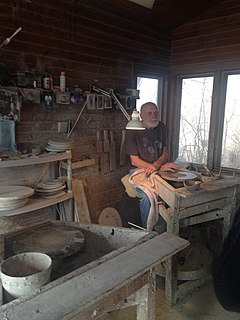A Quote by Warren MacKenzie
It was a wonderful opportunity. And so for two and a half years we lived with [Bernard] Leach.
Quote Topics
Related Quotes
I do remember that when we left [Bernard Leach] after two and a half years, we went home on a boat again - this was before air travel became really easy - and Alix [MacKenzie] turned to me and she said, "You know, that was a great two years of training, but that's not the way we're going to run our pottery."
We had a wonderful trip, a seven-day trip, talking and sitting in the sun and so forth [with Bernard Leach]. And as we were approaching England, Leach said, "Do you have a place to live?" And we said, "No, we didn't." We hadn't worried about that. But Bernard had just separated from his second wife, which we had not realized, and Bernard was a person who could not stand to live alone. So he said, "Would you like to share my house with me?" Naturally we said yes.
In fact, [Bernard Leach] was several generations removed from us. At that time we were there, I think Alix [MacKenzie] and I were 26 and 28, and Leach was about 63, and we thought he was a very old man. I used to always want to help him up the stairs in the house for fear he'd fall. Actually, he was in excellent condition and lived to be much, much older than we ever expected.
Bernard [Leach] had acquired many [Shoji] Hamada works. Some of them, it was interesting - first of all, Hamada worked in St. Ives for about four years before returning to Japan to start his own pottery. He had exhibitions in London, and if these exhibitions didn't sell out, the galleries were instructed to send the remaining work down to the Leach Pottery, where they would go into the showroom for sale. If Bernard saw one that hadn't sold that he really admired, then he would take it (he would buy it), and it would go into the house.
In searching for further training we turned to England and Bernard Leach. We thought since we had responded to his book so strongly that this would be the sort of training that we would like to have. We saved money, during the summer went to Europe, and the first stop was to go to England, visit the Leach Pottery and ask Leach if he would take us on as apprentices.
At the end of that two weeks Bernard [Leach] asked us if we would like to sit with him tending the kiln, the big oil-fired kiln that they had. He was still sitting what we call a kiln watch at that time, and he wondered if we would like to sit the watch with him and talk. So naturally this was our last opportunity to talk with him, so we said yes. We didn't realize Bernard's kiln watch was from 1:00 in the morning until 4:00 AM.
Friends of Bernard's [Leach] came to visit, and when we went to London, we were given introductions to people like Lucie Rie, Hans Coper, Richard Batram. All these people were, let's say, made available to us by a friendship with Leach. In addition there was a potter's group - what was it called? I think it was called the Cornish Potters Society, but I'm not sure of that. Anyway, they had meetings and we would go with Leach to these meetings and meet other potters, and they would have programs where they would discuss pottery and people would interchange ideas.
We asked a lot of questions and we watched everyone who was working in the studio. And we had an opportunity to sit in on discussions, aesthetic discussions at the pottery, which took place generally over tea breaks in the morning and afternoon. So we learned a lot just from being around there [with Bernard Leach ].

















